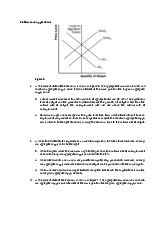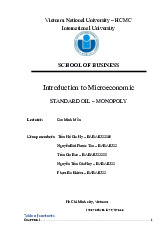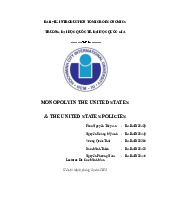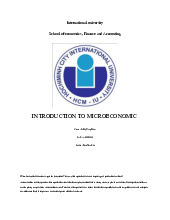





Preview text:
INTERNATIONAL UNIVERSITY VNU- HCM SCHOOL OF BUSINESS (BA117IU) INTRODUCTION TO MICROECONOMICS Fall 2024
Instructor: Nguyen Van Phuong, PhD E-
mail: nvphuong@hcmiu.edu.vn
Office Hours: 8:30-10:30 AM on Monday at Room A2.304 Class sites: IU Blackboard Teaching Assistants: TBA
Should you wish to meet me outside the office hours, please meet after classes or send an email
to arrange an appointment. I will not reply your email if you do not introduce your full name and class. 1
1. INFORMATION ABOUT THE COURSE
1.1. Units of Credit: 3 1.2.
Perquisite and Parallel courses Not applicable
1.3. Relationship of this course to other course offerings
This is core required course for all majors in the Bachelor of Business Administration (BBA). It
focuses on the basic principles of market economy.
1.4. Approach to learning and teaching
The teaching and learning adopted in this course is learner-center, and consequently, requires
active student participation and contribution. Through a range of interactive activities and
teaching strategies, it seeks to engage students in the learning. It also seeks to facilitate
independent learning through individual tasks and research, and fosters collaborative learning
through a range of group activities. It considers prior learning through a range of group activities. 2.
COURSE OBJECTIVES AND OUTCOMES
2.1 COURSE DESCRIPTION:
Microeconomics is the introductory course in economics. The course is designed to teach you
the basic tools of microeconomic analysis. Microeconomics is the branch of economics that
deals with the interaction of households and firms in individual markets. Some of the issues we
will study include how prices and output levels are determined, what happens when governments
intervene in markets, when do markets “fail”, how do markets produce an “efficient” use of a
society’s scarce resources and are market outcomes equitable. Learning “to think like an
economist” should make you a more informed student, consumer, worker and voter.
This course does not assume any prior knowledge of economics. However, if you have enrolled
Macroeconomics, it enables you to get better understanding Microeconomics.
2.2 LEARNING OBJECTIVES and Outcomes
At the completion of this course students will be able to:
Recognize the importance that economic models play in economic analysis.
Understand opportunity cost and how this concept can be applied in all facets of life.
Use supply and demand analysis to predict changes in price/quantities in markets, including
when government policies play essential roles in these markets.
Determine how elasticity affects consumer demand and firms’ production decisions.
Recognize the role that utility plays in consumer consumption choices.
Apply the relationship between production and costs to determine the profit-maximizing
output of firms in different market types.
Understand a body of social science knowledge and its disciplinary perspective. Understand
markets characterized by monopoly and imperfect competition. 2
2.3 Teaching Strategies
The learning system in this course consists of lectures and scheduled
presentations/discussions. Lectures elaborate the appropriate theoretical content in the
textbook and readings. Classes provide a more detailed and refined analysis of both concepts
and applied materials. Classes are strongly oriented towards interactive discussion of the text
and cases. In order to gain the most from the lectures and class activities, the assigned
text/reading should be read before the lecture to participate in the discussions.
3. STUDENT RESPONSIBILITIES AND CONDUCT 3.1. Workload
It is expected that you will spend at least 10 hours per week studying this course. This time
should be made up of reading, working on exercises and problem, group assignment and
attending class lectures and tutorials. In periods where you need to complete assignment or
prepare for examinations, the workload may be greater. 3.2. Attendance
Your regular and punctual attendance at lectures and related seminar (if any) is expected in this
course. University regulations indicate that if students attend less than 80% of scheduled classes
they may be refused final assessment. Regular attendance is essential for successful performance
and learning in this course, particular in view of the interactive teaching and learning approach
adopted. Please inform your lecture if you are unable to attend the class, and arrange for a
classmate to collect any handouts.
3.3. General Conduct and Behavior
You are expected to conduct yourself with considerable and respect for the needs of your fellow
students and teaching staff. Conduct that unduly disrupts or interferes with a class, such as
ringing, or talking on mobile phones, or chatting on internet, is nor acceptable and students may be asked to leave the class.
Most classes will begin with a “cold call” to one specific student that will open the case, which
is selected from the textbook, reference materials, and business news, and provoke class
discussion. In the course of a semester, every student will receive a cold call at least once. After
the opening question, the class will collectively analyze, argue, approach, and persuade polite
society (the class). The instructor’s role is one of orchestration and additional stimulation of discussion. 3.4. Keeping informed
You should take note of all announcements made in lectures, tutorials or on the course website.
From time to time, the University will send important announcements to your through website,
course website and/ or Announcement Board (of School of Business and/ or Academic Affair)
without providing you with a paper copy. You will be deemed to have received this information. 3 3.5 Class Policies
You may use a laptop during class, but it should be used to further concepts and not for
other things such as…, as well as…
Please make every effort to arrive in class on time. Turn all pagers, cell phones, and PDAs
off prior to entering class. They are a disruption to the learning process. You may be asked to
leave the classroom if this policy is violated.
Extra credits will be assigned to an individual who either raises a good question or has a good answer in class. 4. LEARNING ASSESSMENT 4.1. Assessment details
To pass this course, student must:
attempt ALL FOUR assessment tasks
submit/complete all assessment tasks on time attain an
overall pass mark of 50% in the course Assessment Tasks: Tasks Marks Date/ Notes 1. Quizzes 10%
2. Individual presentation (Oral) 20%
Weekly working and oral report in section 14 & 15 3. Mid-term Test 30% Following the school 4. Final Test 40% Following the school
Please note that there is no make-up quiz, midterm exam and final one. 1. Quizzes
The quizzes are usually in the form of multiple-choice questions or short-questions that take 10
– 15 minutes each. Students are allowed to use notes in the quizzes.
2. Individual presentation:
Each person will be assigned a case study and work on it during 10 weeks. Please check
the Blackboard to know your case.
You have to make a presentation (oral report) in the week 14 &15. 3. Mid-term Test
The midterm test will be 90 minutes in length and will be in the form of multiple choices,
problem solving questions and essay questions. 4. Final Test
The final test will be 120 minutes in length and will be in the form of multiple choices, problem
solving questions and essay questions. 4 Grading
The letter grade will be followed by the University.
5. ACADEMIC HONESTY AND PLAGIARISM
The following activities are not permitted in the course:
“1/ Plagiarism: copying or receiving material from a source or sources and submitting this
material as one’s own without acknowledging the particular debts to the source (quotations,
paraphrases, basic ideas), or otherwise representing the work of another as one’s own;
2/ Cheating: receiving information, or soliciting information, from another student or other
unauthorized source, or giving information to another student, with the intend to deceive while
completing an examination or individual assignment;
3/ Falsification of academic materials: fabricating laboratory materials, notes, reports, or
any forms of computer data; forcing an instructor’s name or initials; resubmitting an examination
or assignment for reevaluation which has been altered without the instructor’s authorization, or
submitting a report, paper, materials, computer data, or examination (or any considerable part
thereof) prepared by any person other than the student responsible for the assignment;”
This is a good style guide for references: http://library.concordia.ca/help/howto/turabian.pdf
A plagiarism checker will be used on all papers turned in. Papers that do not give correct
credit for intellectual property will receive a grade of F. Be honest! 6. STUDENT RESOURCES Course Resources
The following text and references are essential for the course. Textbook:
Principles of Microeconomics, 9th Edition, 2021, by N. Gregory Mankiw. Or The older version. Other materials:
• Microeconomics: A Modern Approach, 1st Edition, 2009, by Andrew Schotter.
• Microeconomics, 9th Edition, 2010, by Roger A. Amold You are
encouraged to read Wall Street Journal. 5 e-RESOURCES
This course has dedicated a paperless course. Copies of the syllabus, lecture notes, other
materials and assignments will be posted on the Blackboard.
7. COURSE SCHEDULE Sections Topic 1 Course Introduction
Basic Concepts of the Economics (Chapter 1) 2
Thinking like an Economist (Chapter 2)
Interdependence and the Gains from Trade (Chapter 3) 3 Supply – Demand (Chapter 4) 4
Elasticity and Its Applications (Chapter 5) 5
Supply – Demand & Government (Chapter 6) 6
Consumers_Producers (Chapter 7) 7
Cost of production (Chapter 13) 8 Midterm exam 9
Theories of Consumer Choice (Chapter 21) 10
Perfect competitive market (Chapter 14) 11 Monopoly (Chapter 15) 12
Monopolistic competition (Chapter 16) 13 Oligopoly (Chapter 17) 14 Oral presentation 15 Oral presentation Final Exam
This schedule is able changed when necessary. 6



